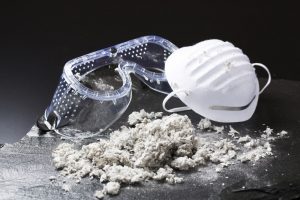Asbestos is the term used for a group of minerals made up of microscopic fibers. These fibers form naturally in certain rocks which then eventually break down into the soil.
When left alone, these fibers are not at all harmful to humans. The problem arises when the asbestos is damaged and the fibers released into the air. The most common reason for airborne asbestos is construction work. Basically, someone cuts into, drills or breaks an asbestos-containing material.
Asbestos is proven to have a disastrous effect on anyone who breathes in these lethal fibers. It’s one of the most common causes of work-related deaths in the construction industry.
Let’s get to know more about this puzzling predicament, and spread awareness on how it can be prevented.
Why is Asbestos Dangerous?
 Despite this organic matter being legally banned for use in construction, asbestos still hides in plain sight: within the nooks and crannies of some modern infrastructure.
Despite this organic matter being legally banned for use in construction, asbestos still hides in plain sight: within the nooks and crannies of some modern infrastructure.
Any buildings built between 1950 and 1990 retain this dangerous substance. So, you might want to check the history of your house or office to be sure you’re safe!
As we mentioned above, asbestos itself is harmless unless it’s disturbed. If the tiny fibers enter your lungs through your mouth or nose, you could get one of several fatal diseases, such as asbestosis (scarring of the lung tissue), pleural disease, or lung cancer.
Therefore, awareness is very important. To give you an accurate illustration of how asbestos may affect your lungs, and lead to high-risk diseases, check out this video.
Products That Contain Asbestos
Now, not all products used for constructing buildings were made with asbestos. However, the following are asbestos-containing materials:
- Millboard, cement sheet, and paper used for insulation around stoves and furnaces.
- Roofs, sidings, and shingles.
- Decorative and soundproofing sprays on ceiling and walls.
- Automobile linings, brake pads, gaskets, and clutch facings.
- Embers and ashes for fireplaces, ironing board covers, hairdryers, stove-top pads, and fireproof gloves.
- Textured paints, joint compounds, and patching compounds for ceilings and walls.
- Vinyl floor tiles, asphalt tiles, rubber tiles, vinyl sheet flooring, and adhesives.
- Hot steam, boilers and hot water pipes.
- Door gaskets, coal furnaces, furnace ducts, and oil furnaces.
- Deck under sheeting.
- Light fixture backings.As they stand, the asbestos within these products is not life-threatening. But if these products are drilled, cut, sawed, scraped, damaged, torn, repaired, or removed improperly, the dangerous fibers will be released into the air.
How to Identify Asbestos in Your Home
Truth be told, there is no actual way of identifying asbestos by yourself. You can’t spot asbestos simply by looking at it, as it’s mixed in with other materials.
Only people trained to identify and remove asbestos are able to do so by using a polarized microscope. Samples are taken from your house and sent to the laboratory for testing. If the test results are positive, you must take action immediately to remove this lethal mineral from your home.
Removing asbestos yourself is not only detrimental to your own and other’s wellbeing, but it’s also illegal in some states. You could end up exposing yourself and others to the harmful fibers. Hence, only licensed asbestos removalists are allowed to do so.
Who Is at Risk of Exposure?
People who have been working in the construction industry have been gravely affected by its exposure. But that was before anybody knew how hazardous it was.
It was discovered when the workers began to show symptoms of asbestos exposure and died.
Nowadays, the entire neighborhood is warned about the potential dangers during asbestos removal. They are all advised to keep their doors and windows closed.
Moreover, asbestos removalists are not allowed to eat or drink anything during the removal process. They have to be in their PPE suits the entire time.
Those living in the neighborhood are warned about the building being abated so that they don’t eat or drink anything near that building. They are also advised to wear masks.
Typically, one-time exposure hardly poses any threat to the lungs. However, multiple exposures may result in serious consequences.
How the Professionals Remove Asbestos
The asbestos removal process typically takes about five days to a week, depending on the size of the area being cleaned. The professionals will start by removing all the furniture and electronic appliances in the house.
The next step is to spray the contaminated area with water to prevent the fibers becoming airborne. Asbestos-coated sheets are dampened and gently removed to be placed in the asbestos-waste container.
All drainpipes and ridge caps must be unbolted and carefully placed in the asbestos waste bin. Nothing should be damaged, scraped or crushed during this procedure. Everything is planned meticulously to prevent any asbestos fibers from flying around.
Once all the possible contaminated objects are safely placed in the waste containers, the boxes are sealed properly and labeled so that others know what’s inside the containers.
Finally, a thorough check must be conducted to ensure the entire area has been cleaned appropriately, and no residue of asbestos can be found anywhere. This inspection must also be conducted in the surrounding area as well.
The waste containers are then transported to the appropriate authority for safe asbestos disposal.
To Sum Up
It’s truly sad that so many people have died from asbestos exposure, mainly workers and families living near asbestos facilities and mines. We can only imagine the pain they must have gone through all for the sake of industrial progress.
Today, exposed workers and families are fighting battles in court to claim compensation. However, the pain of living with a life-long disease may outweigh any legal compensations. Since there is currently no cure for asbestos-related diseases, helping those affected may give them some relief.
Thankfully, people are more cautious now, and steps are being taken to remove all objects made from asbestos. Please help us in our goal to spread awareness about asbestos and take steps to abolish this mineral from all infrastructure contaminated by it.






